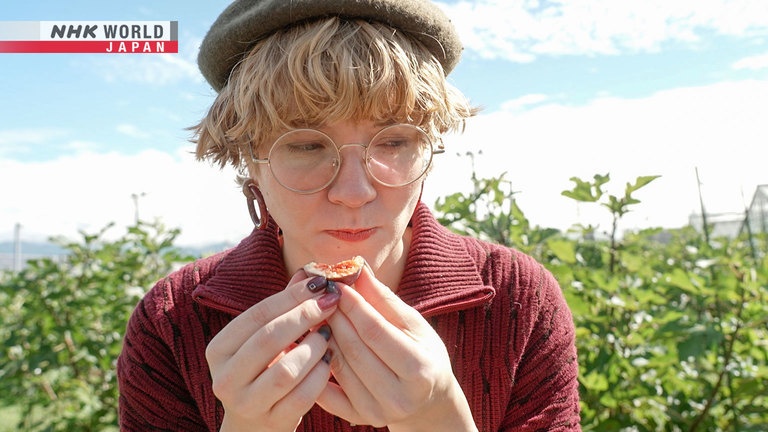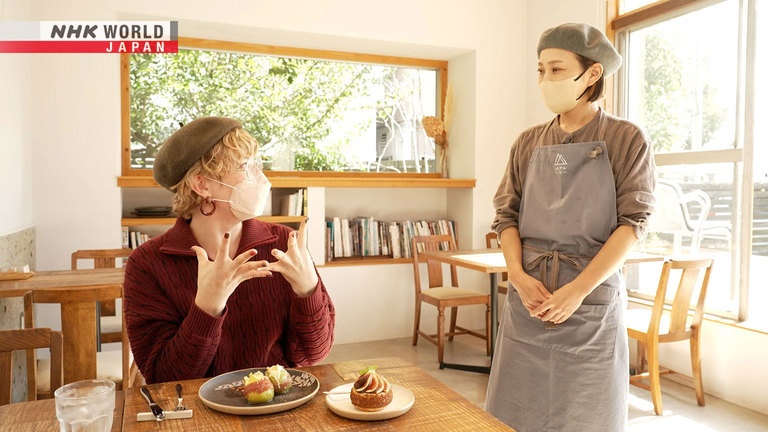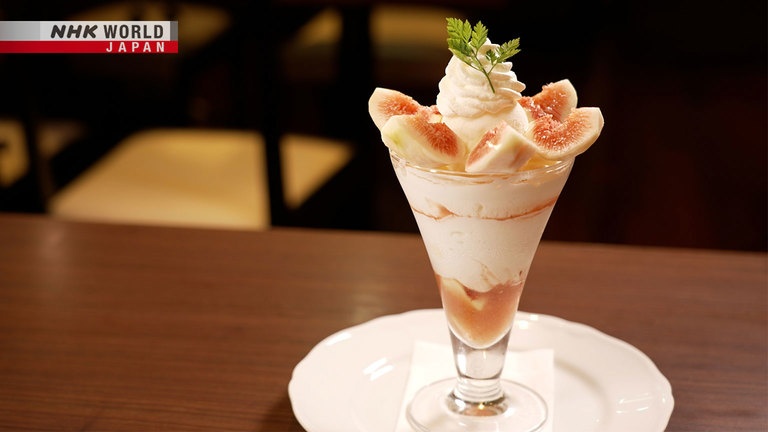FIG
Delicate and easy to spoil, figs are often sold dry. But in Japan, raw consumption is growing ever more popular. An orchard in Shizuoka Prefecture, where many of Japan's fruits are grown, is hard at work cultivating new varieties. Each type offers a unique flavor, color and texture to recipes, demonstrating the fig's true versatility as an ingredient. Discover how the fruit is enhancing Japanese cuisine, from sweet to savory. Enter the fascinating world of figs. (Reporter: Kailene Falls)




Transcript
Tokyo: this world-class metropolis is a veritable gourmet wonderland.
Discover the stories behind the ingredients that make this city so delicious - so "oishii."
Figs are sweet and gooey delights.
Their unique texture comes from the red part in the middle.
Did you know this is actually a cluster of inverted flowers?
Some grow in summer; others grow in fall.
From June to November, there's tasty figs for all!
Mostly eaten raw in Japan, they're soaring in popularity.
Cakes, tarts - all kinds of fig desserts are popping up everywhere.
They're being used in other ways too, even in savory recipes!
I love this.
"Oishii!"
Enter the fascinating world of figs.
Trails to Oishii Tokyo.
Hi, It's Kailene.
Today, we'll be talking about figs.
Growing up in the midwestern USA, I didn't really have the opportunity to try fresh figs, and I've only had dry figs a few times in my life.
I always associated them with wine and cheese and fancy parties.
In Japan, however, figs are a much more popular ingredient, and I'm excited to learn about how figs are produced in Japan
as well as how Japanese people use figs to make "oishii" foods.
Kailene begins at a long-established fruit shop.
High-end fruity desserts are all the rage in Japan.
Every season comes with a tasty fruit to enjoy.
Many people eat them as-is, but parfaits made of ice cream, fruit, and whipped cream are also very popular.
You may remember that Kailene is a pro illustrator who mainly draws food.
The beauty of Japanese parfaits makes them a wonderful subject.
She thinks they're tasty too!
Oh!
I think this is what we're here for!
We've got a beautiful, it looks like a fig parfait.
I'm really excited to try it.
The seasonal menu has parfaits, fruit sandwiches, and waffles.
I love fruit parfaits.
I know muscat grapes
are popular in Japan.
And their color really
stands out on this menu.
Does that overshadow the figs?
Not at all.
We serve both through September
as part of our seasonal menu.
Both sell well. Some days, we
even serve more figs than grapes.
What attracts people to figs?
Their unique texture.
They're moist and a bit crunchy.
They have a refreshing flavor.
Figs are soft and delicate.
One false move could spoil them.
They're peeled and cut carefully to prevent damage.
Their work is almost surgical.
The figs are served on vanilla ice cream and frozen yoghurt.
Thanks for waiting.
Here is our fig parfait.
Beautiful!
Lovely fig color.
Looks yummy.
"Oishii." So good!
The texture is just perfect.
Honestly, it's like got a very earthy sweetness to it.
And the outside is just perfectly soft, and then you've got the little bit of crunch with the seeds in the middle.
So good.
Fig parfait - a lovely bouquet of sweetness.
Figs grow more popular with every passing year.
With a temperate climate, Shizuoka - near Tokyo - is a fruit paradise.
Kailene is there to check out a fig orchard.
- Good morning. I'm Kailene.
- Nice to meet you. I'm Tanzawa.
Thanks for having me.
- Are these figs?
- Yes.
I've never seen them growing before.
Are these fig plants?
They don't look this way in the wild.
We shape them to make harvesting easier.
Thinning out the branches gives the leaves and fruit more sun.
- It smells so good.
- Yeah? You can smell it?
- As soon as I walked in. Is that the figs?
- It is.
- It's like juice!
- It's a sweet smell.
Right!
And the leaves are big!
Not what I expected.
These are different from the type
commonly eaten in Japan.
Are there a lot of varieties?
The world has over 700 types.
- 700?
- There are many varieties.
The orchard grows around 10 types that were carefully selected from around 120, mostly from Europe.
Some have dark peels, others have green.
Some are dark inside; others have large inverted flowers.
In Japan, a variety called Masui Dauphine is the most widely consumed.
The Japanese word for fig - ichijiku - basically means "fruit with no flower."
The reason lies in the fleshy part of the fruit.
The inside is made up of inverted flowers, with no visible petals on the outside.
Kailene heads to the greenhouse to learn more about cultivation.
I saw some figs outside.
Are these a different type?
The same type, but grown differently.
We grow them in pots here.
That means the root area is narrower.
This way, they focus less on
growing large, and more on bearing fruit.
So, growing them in pots makes more product.
It also increases the sugar content.
Is timing a factor when harvesting figs?
Yes. Timing is everything.
When do you do it?
Early in the morning.
We begin while it's still dark.
Figs grow at nighttime.
We water them until evening
and leave them overnight.
In the morning, they're less hydrated,
and packed with flavor.
Unlike bananas or melons, figs don't continue to ripen after they're harvested.
This makes timing difficult.
This type turns black when fully ripe.
But that's not the final clue.
We have to touch them to know for sure.
Are any of them ready today?
I think so.
Would you like to harvest some?
Yes, please! I'd love to.
Touch here. Carefully!
It's soft.
That means it's ready.
Go ahead.
May I?
- Like this?
- Yep! Good job!
Lovely color.
I've never eaten or handled them raw.
I thought it would be firmer.
Actually, they need to be shipped to stores.
So, we harvest them while they're
still firm, to prevent damage.
That makes it tricky.
Now, she'll try some that you rarely see on the Japanese market.
It's soft.
Very juicy.
Itadakimasu!
It's a bit sour.
Not just sweet.
And the texture is great.
Sourness is the unique feature of this type.
It's also sweet with a
characteristic fig flavor.
It's complex, with layers of umami.
I love it. This is so yummy.
I could keep eating them.
Let's try the next one.
This type stays green.
It's fully ripe.
Let's cut it open.
Great color!
Beautiful.
So sweet.
It's soft, but the florets have a
crunchy texture and strong flavor.
They're not too acidic,
or too sweet.
It's a balanced flavor.
With each variety comes a different texture and level of sweetness.
Kailene heads to a local cafe to try food made with freshly-farmed figs from the orchard she just visited.
Thanks for waiting.
- Our fig dishes.
- Not only dessert?
This has three types of whole figs!
It's a test recipe that's not on the menu yet.
Looks good. Smells great too!
Cheese and figs?
This is a first! Looks yummy!
Itadakimasu!
Fabulous!
- So delicious.
- Thank you.
You just ate a type called Bourjasotte Grise.
- It has a perfect sweet-sour balance.
- It's great baked like this.
The juices come out
as soon as you take a bite.
Some may be surprised to see figs
inside of a gratin dish.
But figs go great with cheese.
Next is a cream puff with slices of Figue de Solliès, a darker type.
With chocolate!
This is great!
This variety goes well with chocolate.
It enhances the fig flavor.
- This variety is a bit sour, no?
- It is.
The sweetness of the chocolate and
the texture of the cream puff are irresistible.
Thank you.
The fun lies in discovering which type of fig works best in a recipe.
However, figs don't keep well, so they're often processed.
Let's learn how to make jam.
It's quite soft.
They're ripe and ready to eat.
I don't know much about figs,
but I was expecting a harder peel.
The peels keep the texture intact.
It's better to use them.
We eat a lot of peels in the US.
Except for citrussy fruits, I guess.
A lot of people eat apples
or even mangoes with the peels.
- Really?
- Yeah.
Figs are cooked with sugar in a pan.
Stirring it activates the smell.
Right.
This is cooked down over high heat.
Looks great.
Scum will form on the top.
Scum is forming.
It's bitter and affects overall flavor,
so it needs to be skimmed off.
This isn't common in American cooking.
A lot of Japanese recipes call for removing scum.
I was surprised when I first saw that.
Once the peels are soft, some lemon juice is squeezed in, and voila.
There's sourness, and the fig sweetness.
Enjoying that?
- This is tasty!
- Great.
In Shizuoka, I was able to learn so much about figs, from how they're grown to the different varieties available.
They were delicious to compare, and trying them in different ways really opened my eyes to the many different possibilities of this delicious ingredient.
Thought to come from the Arabian Peninsula, figs were brought to Japan in the early 17th century to be grown for medicinal purposes.
Figs are grown all throughout Japan, and each region of Japan has its own special type of sweet that uses figs.
Today, we've gathered together a number of those sweets to try.
Kailene begins with two Japanese desserts containing whole figs.
Here we go.
This is "daifuku" - mochi cake with a sweet bean filling.
Ones with a strawberry or mikan orange in the middle are quite popular.
Because the whole fig is inside the daifuku, it's really nice and fresh, and actually quite juicy, which is something I'm not super used to in a "daifuku."
So, it's highly recommended.
These figs were soaked in a sweet syrup.
Because they're crusted in sugar, I was expecting them to be super-duper sweet, but more than anything, that sugar gives them sort of an interesting crunch on the outside.
And they've still got that nice fig texture, that fruit flavor, on the inside.
I really like the different textures you can experience in this one.
Now for "yokan," a sweet made of bean paste and agar.
One uses red bean paste, the other uses white.
Itadakimasu.
It's interesting how the fig flavor really balances between that white bean paste.
It's there.
They're both there.
And neither of them are particularly losing to each other.
They have a really nice balance between the two.
Very easy to eat.
This is actually more familiar to me in flavor to the dried figs that I ate growing up.
I think it's, the texture of the fig is still quite strong in this one.
And although it uses red bean paste, somehow it seems very similar to fig cookies that I ate when I was younger.
The figs were pickled in rum.
They say this goes great with bread or wine.
Last but not least, a classic Japanese dessert that melts in your mouth.
I'm guessing nobody knows what this one is.
This is something called "warabi-mochi."
I'm honestly not exactly sure how it's made, but what is really interesting about it is its really jiggly texture.
A Jell-O almost, but a little bit softer than a Jell-O.
But you've got a nice fig... figgy feeling on the inside of it.
The texture is really fun and the flavor's great.
Grown all over Japan, figs are now delicacies in several regions.
Figs are also a prized ingredient in savory Japanese recipes.
Uchiyama Hidehito has been using figs at this restaurant in Ginza since he opened it 20 years ago.
Whole figs are pulled apart by hand - peels intact.
He'll make two types of "aemono" - a traditional salad.
This is "shira-ae."
Figs and carrot leaves are covered in tofu dressing.
Big piece of fig in here.
Here we go!
Itadakimasu!
Wow.
It has a gentle flavor.
This is "goma-ae."
Figs and Japanese wild parsley are covered in sesame dressing.
"Oishii!"
Both dressings are very creamy,
but they offer different flavors.
Each salad has a different dressing,
but they contain the same figs.
The tofu dressing is mild,
so carrot leaves add a kick.
Sesame dressing is quite rich.
Japanese wild parsley provides texture
without adding more aroma.
It goes well with figs too.
Next, peeled figs are steamed whole.
The topping is a mixture of miso paste and fig nectar.
This is great!
So yummy!
Now, he'll bake some with the same miso paste.
This is called fig "dengaku."
Interesting. This is good too.
It seemed like meat at first.
Figs are soft, even when eaten raw.
Steaming them cooks them through.
They only cook partially when baked.
So, the textures are different.
Even using the same ingredients, cooking them
differently offers a different experience.
Figs with miso - sweet and savory heaven.
Last up - figs simmered with duck meat.
Duck meat is covered in flour, and cooked in dashi soup stock, mirin, and light soy sauce.
Why use duck meat?
Figs are very tender.
Duck meat is firm.
The two textures complement each other.
Itadakimasu.
I like this. "Oishii!"
I love duck meat, but it has
a fairly unique flavor and texture.
I'm surprised it goes so well with figs,
since they're much softer and sweeter.
Figs are a versatile ingredient.
You can use them freely without
getting in the way of other ingredients.
In fact, other ingredients enhance the fig flavor.
Sweet, gooey figs are more than just a fruit.
Their versatility takes them far beyond the dessert menu.
And as cultivation gives birth to new varieties, more recipes are likely to come.
The perfect fig is out there for everyone.
In Tokyo, every ingredient has its own story.